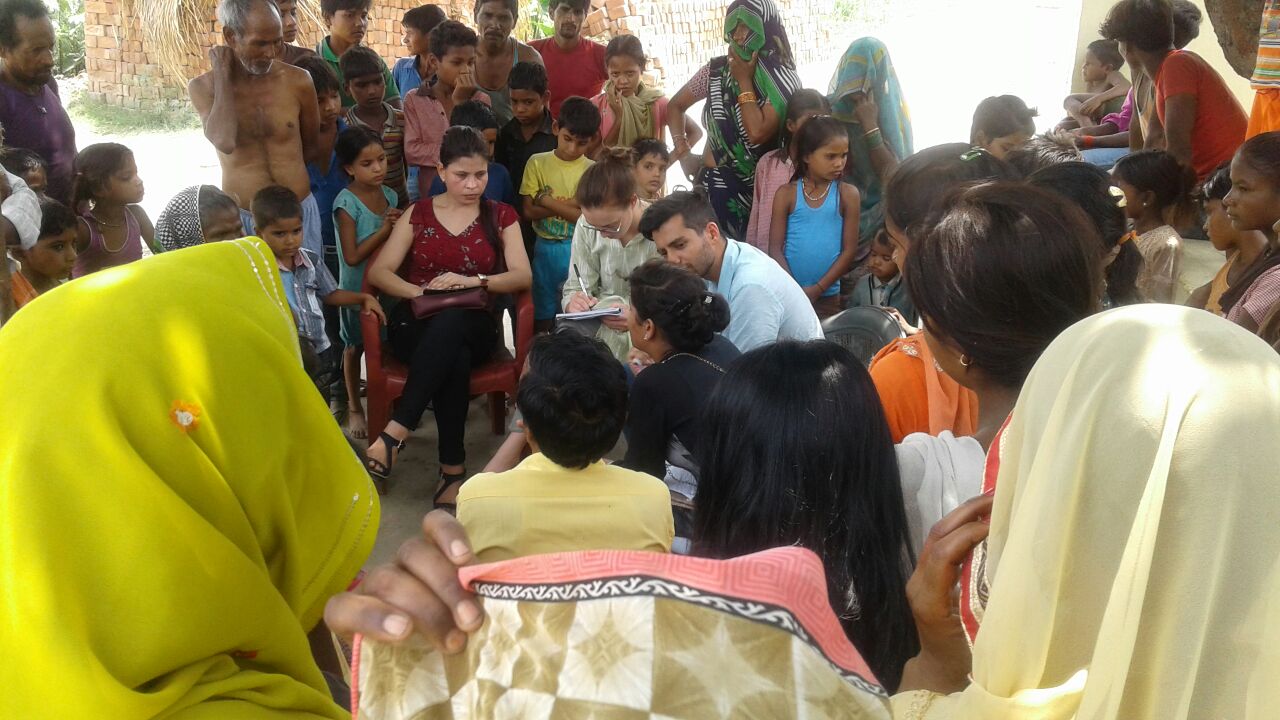Seva Team Blog – 2018 IBD
Written by Jocelyn Brown, Rachel Lee, Grant Hannigan, Josue Chavarin, and Gagan Dhaliwal
It’s 110 degrees outside. Every bump of the road jostles us back and forth as we sit on stretchers in the back of the hospital ambulance. Weaving down dirt roads that look way too narrow for our vehicle, let alone two lanes of traffic, the driver uses the siren to announce our arrival, to both wandering buffalo and massive trucks filled with just-cut sugarcane. Within minutes of leaving the hospital, we are passing small farming villages. Goats, stray dogs and buffalo rest in the shade of ramshackle structures, along with villagers who stare at us as we drive by. Little fans in the back of the ambulance blow hot air in our faces, making it feel like we’re in the middle of a hot, dry sauna.
After stopping to ask directions several times, we finally locate our first interviewee. Today, Gagan and I are interviewing patients who visited Dr. Shroff’s Charity Eye Hospital in Mohammadi, India, and were told that they needed cataract surgery but haven’t come back yet to schedule it. We’re hoping to learn, through our teenage translators Srishti and Gracy, why they haven’t come back to the hospital. Every trip we take outside of the hospital walls has taught us an incredible amount about the surrounding communities and their day-to-day lives. We also usually come back exhausted and completely wiped from the Indian heat after only a few hours.
The first man we meet is prone on a cot underneath a straw hut and comes out to meet us. He’s shirtless, hunched from the waist around a wooden walking stick, and wearing thick, coke-bottle glasses. The first thing our translator tells us after introducing us is that he drinks alcohol. He doesn’t have any family members who can take him back to the hospital, and so he relies on others for transportation. Boiling in the sun, struggling to get any concrete details about why he might not want to come back to Shroff’s, we quickly decide to move on.
Our next interview is the opposite experience. We pull up to through the center of another village and step out of the ambulance. All of the houses around us seem to be made out of mud and straw. Several children seem to be the only ones who have any energy as they run around playing with each other and a stray dog. The community outreach coordinator for the hospital learns that our next patient is out working in the fields. While other members of the community go fetch him, chairs and water are suddenly precured from nowhere. We see very few women, just glimpses of their colorful garb from open doorways. As we wait for our interviewee, a small crowd of children and interested men starts to form. By the time our interviewee has arrived, a crowd has fully surrounded our little half-moon of chairs.
We’ve worked with our translators ahead of time so they know the types of questions we’re hoping to understand: how did you first hear about Shroff’s? What motivated you to seek care there? Did you understand what the doctor told you about cataract surgery? Why haven’t you returned to Shroff’s for surgery? We receive very brief answers in return: I was very satisfied with my experience. I wouldn’t change anything; the doctors and facilities are the best. Now surrounded with a full crowd of villagers, I wonder how much this man feels like sharing with these foreigners who have suddenly descended upon him and his home.

As our translators work to glean why this man hasn’t returned to the hospital for surgery (he doesn’t have the time), Gagan and I start to realize the enormity of our task. Our goal is to find untapped sources of new paying patient revenue, so that the hospital can work towards financial sustainability. But as our interviews in the community continue (we only make it through two more before we’re completely wiped by the heat), we realize we will not find the patients we’re looking for here.
We discover that the sugar cane farmers are paid 1-2 times a year for their crop and are making at most $5,000 a year. If these villagers are challenged with the basics of transportation and finding the time to make the trip to the hospital, none of our fancy, MBA pricing models are going to make any bit of difference in this community. Our impression that these patients would price shop for their surgery is immediately dispelled once we realize the simple, minimal lifestyle that describes 80% of this entire state of 200 million people. It’s only Monday of our second week and we certainly have our work cut out for us to identify sources of paying patients.







